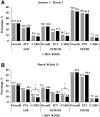Rates of Acute Myocardial Infarction During the COVID-19 Pandemic
- PMID: 35348103
- PMCID: PMC8784080
- DOI: 10.7812/TPP/21.074
Rates of Acute Myocardial Infarction During the COVID-19 Pandemic
Abstract
Background: During the early phases of the COVID-19 pandemic pandemic, stay-at-home orders and fear of acquiring COVID-19 may have led to an avoidance of care for medical emergencies, including acute myocardial infarction (AMI). We evaluated whether a decline in rates of AMI occurred during the COVID-19 stay-at-home order.
Methods: Rates of AMI per 100,000 member-weeks were calculated for Kaiser Permanente Southern California patients from January 1 to March 3, 2020 (prepandemic period) and from March 20 to July 31, 2020 (pandemic period), and during the same periods in 2019. Rate ratios (RRs) were calculated comparing the time periods using Poisson regression. Case fatality rates (CFRs) were also compared.
Results: Rates of AMI were lower during the pandemic period of 2020 compared to the same period of 2019 [3.20 vs 3.76/100,000 member-weeks; RR, 0.85; 95% confidence interval (CI) 0.80-0.90]. There was no evidence that rates of AMI differed during the 2020 prepandemic period compared to the same period in 2019 (4.45 vs 4.24/100,000 member-weeks; RR, 0.95; 95% CI, 0.88-1.03). AMI rates were lower during the early pandemic period (March 20-May 7: RR, 0.70; 95% CI, 0.66-0.77), but not during the later pandemic period (May 8-July 31: RR, 0.95; 95% CI, 0.88-1.02) compared to 2019. In-hospital and 30-day case fatality rates were higher during the pandemic period of 2020 compared to 2019 (8.8% vs 6.1% and 6.5% vs 5.0%, respectively).
Conclusion: AMI rates were lower during the COVID-19 pandemic compared to the same period in 2019. During stay-at-home orders, public health campaigns that encourage people to seek care for medical emergencies are warranted.
Conflict of interest statement
Figures


References
-
- Office of Governor Gavin Newsom. Governor Newsom declares state of emergency to help state prepare for broader spread of COVID-19. 2020. Accessed November 9, 2021. https://www.gov.ca.gov/2020/03/04/governor-newsom-declares-state-of-emer...
-
- U.S. Department of Homeland Security. COVID-19 emergency declaration. 2020. Accessed October 22, 2020. https://www.fema.gov/news-release/20200726/covid-19-emergency-declaration
-
- Office of Governor Gavin Newsom. Governor Gavin Newsom issues stay at home order. 2020. Accessed October 22, 2020. https://www.gov.ca.gov/2020/03/19/governor-gavin-newsom-issues-stay-at-h...
-
- Mehrotra A, Chernew M, Linetsky D, Hatch H, Cutler D. The impact of the COVID-19 pandemic on outpatient visits: A rebound emerges. 2020. Accessed October 22, 2020. https://www.commonwealthfund.org/publications/2020/apr/impact-covid-19-o...
-
- Wong LE, Hawkins JE, Langness S, Murrell KL, Iris P, Sammann A. Where are all the patients? Addressing COVID-19 fear to encourage sick patients to seek emergency care. 2020. Accessed October 22, 2020. https://catalyst.nejm.org/doi/full/10.1056/CAT.20.0193 - DOI
MeSH terms
LinkOut - more resources
Full Text Sources
Medical

